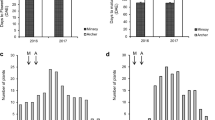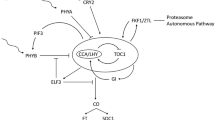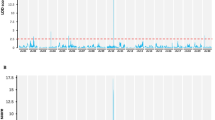Abstract
Flowering in mungbean is irregular, resulting in asynchronous pod maturity that necessitates multiple harvests per crop and increases time and labor costs. Control of flowering time is essential for increasing mungbean yield; however, few studies to date have examined quantitative trait loci (QTL) associated with flowering time in mungbean. Here, a genetic map was constructed by genotyping-by-sequencing in an F6 population of 190 recombinant inbred lines (RILs) derived from a cross between VC1973A and V2984. In total, 1321 SNP markers were incorporated into 11 linkage groups. Days-to-first-flowering (DFF) and days-to-flowering (DF) were determined, and QTL analysis was performed. A QTL for both DFF and DF was detected on chromosome 3 (Chr3) with LOD scores of 15.8 and 18.7, respectively. Flowering-related QTLs and genes are well-studied in soybean. Syntenic analysis between mungbean and soybean revealed synteny of the mungbean Chr3 region with a soybean region containing QTLs for first flower that mapped to key flowering genes encoding phytochrome A (PHYA). A candidate flowering gene, Vradi03g07170 (VrPHYA), homologous to soybean PHYA, was identified in the Chr3 syntenic block. In summary, mungbean flowering QTLs were identified on a high-density genetic map and a candidate flowering gene was discovered that will be highly helpful for controlling flowering time in a mungbean breeding program.



Similar content being viewed by others
References
Abe J, Xu D, Miyano A, Komatsu K, Kanazawa A, Shimamoto Y (2003) Photoperiod-insensitive Japanese soybean landraces differ at two maturity loci. Crop Sci 43:1300–1304
Bernard RL (1971) Two major genes for time of flowering and maturity in soybeans. Crop Sci 11:242–244
Bonato ER, Vello NA (1999) E6, a dominant gene conditioning early flowering and maturity in soybeans. Genet Mol Biol 22:229–232
Buzzel RI (1971) Inheritance of a soybean flowering response to fluorescent-daylength conditions. Can J Genet Cytol 13:703–707
Buzzel RI, Voldeng HD (1980) Inheritance of insensitivity to long day length. Soybean Genet Newsl 7:26–29
Chankaew S, Somta P, Sorajjapinun W, Srinives P (2011) Quantitative trait loci mapping of Cercospora leaf spot resistance in mungbean, Vigna radiata (L.) Wilczek. Mol Breed 28:255–264
Cober ER, Voldeng HD (2001) A new soybean maturity and photoperiod-sensitivity locus linked to E1 and T. Crop Sci 41:698–701
Cober ER, Molnar SJ, Charette M, Voldeng HD (2010) A new locus for early maturity in soybean. Crop Sci 50:524–527
Fakir MSA, Mondal MMA, Ismail MR, Ashrafuzzaman M (2011) Flowering pattern and reproductive efficiency in mungbean. Int J Agric Biol 13:966–970
Gepts P, Beavis WD, Brummer EC, Shoemaker RC, Stalker HT, Weeden NF, Young ND (2005) Legumes as a model plant family. Genomics for food and feed. Report of the Cross-legume Advances Through Genomics Conference. Plant Phys 137:1228–1235
Graham PH, Vance CP (2003) Legumes: importance and constraints to greater use. Plant Physiol 131:872–877
Hong EH, Lee YH, Kim SD, Hwang YH, Moon YH, Ham YS (1983) New disease resistant and high yielding mungbean variety “Seonhwanogdu”. Res Rep 25:178–180
Humphry ME, Lambrides CJ, Chapman SC, Aitken EAB, Imrie BC et al (2005) Relationships between hard-seededness and seed weight in mungbean (Vigna radiata) assessed by QTL analysis. Plant Breed 124:292–298
Isemura T, Kaga A, Tabata S, Somta P, Srinives P, Shimizu T, Jo U, Vaughan DA, Tomooka N (2012) Construction of a genetic linkage map and genetic analysis of domestication related traits in mungbean (Vigna radiata). PLoS ONE 7:e41304
Isobe K, Kokubun M, Tsuboki Y (1995) Effects of soybean raceme-order on pod set and seed growth in three cultivars. Jpn J Crop Sci 64:281–287
Jain M, Misra G, Patel RK, Priya P, Jhanwar S, Khan AW, Shah N, Singh VK, Garg R et al (2013) A draft genome sequence of the pulse crop chickpea (Cicer arietinum L.). Plant J 74:715–729
Joehanes R, Nelson JC (2008) QGene 4.0, an extensible Java QTL-analysis platform. Bioinformatics 24:2788–2789
Kang YJ, Kim SK, Kim MY et al (2014) Genome sequence of mungbean and insights into evolution within Vigna species. Nat Commun 5:5443
Kim MY, Shin JH, Kang YJ, Shim SR, Lee SH (2012) Divergence of flowering genes in soybean. J Biosci 37:857–870
Kim MY, Kang YJ, Lee T, Lee SH (2013) Divergence of flowering-related genes in three legume species. Plant Gen. doi:10.3835/plantgenome2013.03.0008
Kim SK, Lee T, Kang YJ, Hwang WJ, Kim KH, Moon JK, Kim MY, Lee SH (2014) Genome-wide comparative analysis of flowering genes between Arabidopsis and mungbean. Genes Genom 36:799–808. doi:10.1007/s13258-014-0215-8
Kosambi DD (1944) The estimation of map distance from recombination values. Ann Eugen 12:172–175
Kumari P, Verma SK (1983) Genotypic differences in flower production, shedding and yield in mungbean. J Agric Sci 99:219–223
Kuroda T, Saitoh K, Mahmood T, Yanagawa K (1998) Differences in flowering habit between determinate and indeterminate types of soybean. Plant Prod Sci 1:18–24
Lambrides CJ, Godwin ID (2007) Mungbean. In: Kole C (ed) Pulses, sugar and tuber crops, vol 3., Series: Genome mapping and molecular breeding in plantsSpringer, Berlin, pp 69–90
Lambrides CJ, Godwin ID, Lawn RJ, Imrie BC (2004) Segregation distortion for seed testa color in mungbean (Vigna radiata L. Wilczek). J Hered 95:532–535
Liu B, Kanazawa A, Matsumura H, Takahashi R, Harada K, Abe J (2008) Genetic redundancy in soybean photoresponses associated with duplication of phytochrome A gene. Genetics 180:995–1007
Liu W, Kim MY, Kang YJ, Van K, Lee Y-H, Srinives P, Yuan DL, Lee S-H (2011) QTL identification of flowering time at three different latitudes reveals homeologous genomic regions that control flowering in soybean. Theor Appl Genet 123(4):545–553
McBlain BA, Bernard RL (1987) A new gene affecting the time of flowering and maturity in soybean. J Hered 78:160–162
Mei L, Cheng XZ, Wang SH, Wang LX, Liu CY et al (2009) Relationship between bruchid resistance and seed mass in mungbean based on QTL analysis. Genome 52:589–596
Molnar SJ, Rai S, Charette M, Cober ER (2003) Simple sequence repeat (SSR) markers linked to E1, E3, E4, and E7 maturity genes in soybean. Genome 46:1024–1036
Mondal MMA (2007) A study of source-sink relation in mungbean. Dissertation, Bangladesh Agricultural University
Mondal MMA, Hamid MA (1998) Flowering pattern and reproductive efficiency in 30 groundnut mutants. Bangladesh J Nucl Agri 14:14–17
Mondal MMA, Fakir MSA, Juraimi AS, Hakim MA, Islam MM, Shamsuddoha ATM (2011a) Effects of flowering behavior and pod maturity synchrony on yield of mungbean [Vigna radiata (L.) Wilczek]. Aust J Crop Sci 5:945–953
Mondal MMA, Akter MB, Rahman MA, Fakir MSA (2011b) Effect of foliar application of nitrogen on growth and yield in mungbean. Legume Res 34:166
Mondal MMA, Puteh AB, Malek MA, Ismail, Rafii MY, Latif MA (2012) Seed yield of mungbean (Vigna radiata (L.) Wilczek) in relation to growth and developmental aspects. Sci World J 212:425168
Ono N, Ishida K, Yamashino T, Nakanishi H, Sato S, Tabata S, Mizuno T (2010) Genomewide characterization of the light-responsive and clock-controlled output pathways in Lotus japonicus with special emphasis of its uniqueness. Plant Cell Physiol 51:1800–1814
Sato S, Nakamura Y, Kaneko T, Asamizu E, Kato T, Nakao M, Sasamoto S, Watanabe A, Ono A, Kawashima K et al (2008) Genome structure of the legume, Lotus japonicus. DNA Res 15:227–239
Schmutz J, Cannon SB, Schlueter J, Ma J, Mitros T, Nelson W, Hyten DL, Song Q, Thelen JJ, Cheng J, Xu D, Hellsten U, May GD, Yu Y, Sakurai T et al (2010) Genome sequence of the palaeopolyploid soybean. Nature 463:178–183
Shanmugasundaram S, Keatinge JDH, Hughes J (2009) Counting on beans: mungbean improvement in Asia. In: Spielman DJ, Pandya-Lorch R (eds) Millions fed: proven successes in agricultural development. IFPRI, Washington DC, pp 103–108
Simpson GG, Dean C (2002) Arabidopsis, the Rosetta stone of flowering time? Science 296:285–289
Varshney RK, Chen W, Li Y, Bharti AK, Saxena RK, Schlueter JA, Donoghue MT, Azam S, Fan G, Whaley AM, Farmer AD, Sheridan J, Iwata A, Tuteja R, Penmetsa RV et al (2012) Draft genome sequence of pigeonpea (Cajanus cajan), an orphan legume crop of resource-poor farmers. Nat Biotechnol 30:83–89
Wang Y, Tang H, Debarry JD, Tan X, Li J, Wang X, Lee TH, Jin H, Marler B, Guo H, Kissinger JC, Paterson AH (2012) MCScanX: a toolkit for detection and evolutionary analysis of gene synteny and collinearity. Nucleic Acids Res 40:e49
Watanabe S, Hideshima R, Xia Z, Tsubokura Y, Sato S, Nakamoto Y, Yamanaka N, Takahashi R, Ishimoto M, Anai T, Tabata S, Harada K (2009) Map-based cloning of the gene associated with the soybean maturity locus E3. Genetics 182:1251–1261
Yamanaka N, Ninomiya S, Hoshi M, Tsubokura Y, Yano M, Nagamura Y, Sasaki T, Harada K (2001) An informative linkage map of soybean reveals QTLs for flowering time, leaflet morphology and regions of segregation distortion. DNA Res 8:61–72
Young ND, Debellé F, Oldroyd GE, Geurts R, Cannon SB, Udvardi MK, Benedito VA, Mayer KF, Gouzy J, Schoof H, Van de Peer Y, Proost S, Cook DR et al (2011) The Medicago genome provides insight into the evolution of rhizobial symbioses. Nature 480:520–524
Zhang Y, Zhao L, Li H, Gao Y, Li Y, Wu X, Teng W, Han Y, Zhao X, Li W (2013) GmGBP1, a homolog of human ski interacting protein in soybean, regulates flowering and stress tolerance in Arabidopsis. BMC Plant Biol 13:21
Acknowledgements
This work was supported by Korea Institute of Planning and Evaluation for Technology in Food, Agriculture, Forestry and Fisheries (IPET) through the Agri-Bio Industry Technology Development Program, funded by the Ministry of Agriculture, Food and Rural Affairs (MAFRA) (114054-3), Republic of Korea.
Author information
Authors and Affiliations
Corresponding author
Electronic supplementary material
Below is the link to the electronic supplementary material.
Rights and permissions
About this article
Cite this article
Hwang, W.J., Ha, J., Lee, T. et al. A candidate flowering gene in mungbean is homologous to a soybean Phytochrome A gene. Euphytica 213, 79 (2017). https://doi.org/10.1007/s10681-017-1866-8
Received:
Accepted:
Published:
DOI: https://doi.org/10.1007/s10681-017-1866-8




